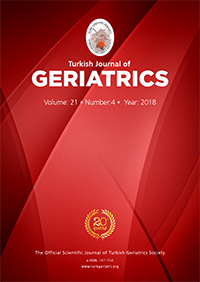2Bahçeşehir University, Physiotherapy and Rehabilitation, İstanbul, Turkey DOI : 10.31086/tjgeri.2018.69 Introduction: In the presented study it was aimed to observe the effects of dual-task on static and dynamic balance and to present if static and dynamic balance training under dual-task performance effect the static and dynamic balance ability positively among the older adults having an institutional living.
Materials and Method: Fifty volunteer individuals (72.02±6.60 years of age, ranging between 64 and 91; 12% women, n=6,88% men, n=44) took part in this study. Evaluations as Barthel Activity of Daily Living Index, Berg Balance Scale and Berg Balance Scale Under Dual-Task Performance were performed both before and after trainings. The participants were divided into two groups by computer-generated randomization table: Group A (n=26, number of sessions=5) and Group B (n=24, number of sessions=7).
Results: Balance score was not affected by dual-task performance, and no differences were found between groups (p>0.05). For groups, balance score both with and without dual-task performance showed positive improvement after training (p=0.00).
Conclusion: Training had positive effects for both group"s balance with and without dual-task performance, but not affected by the session numbers. Physiotherapists should prefer 5 training instead of 6,7 or 8. Yet it could be cost-effective by providing important health benefits, time gains, labor force at relatively low cost. Besides, the study offers standardized flow for both assessment and training on balance under dual-task performance for the older adult population.
Keywords : Task Performance and Analysis; Activities, Daily Living; Aged
